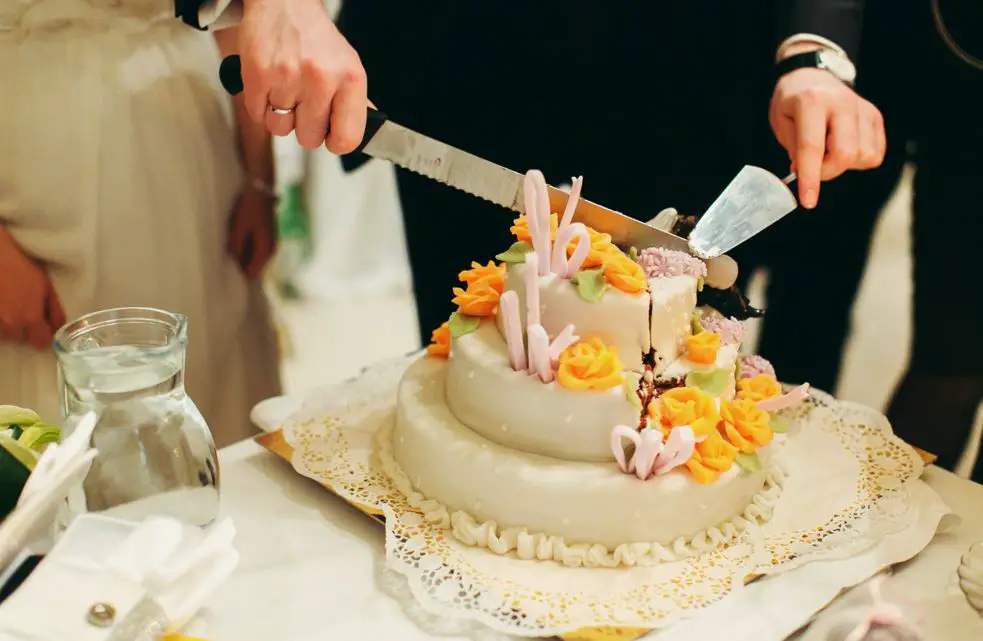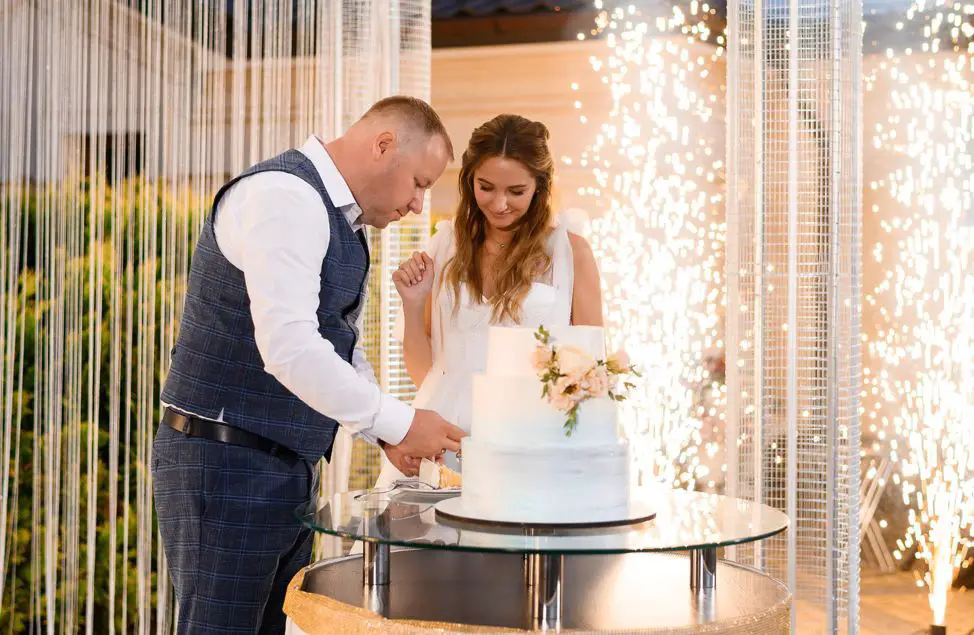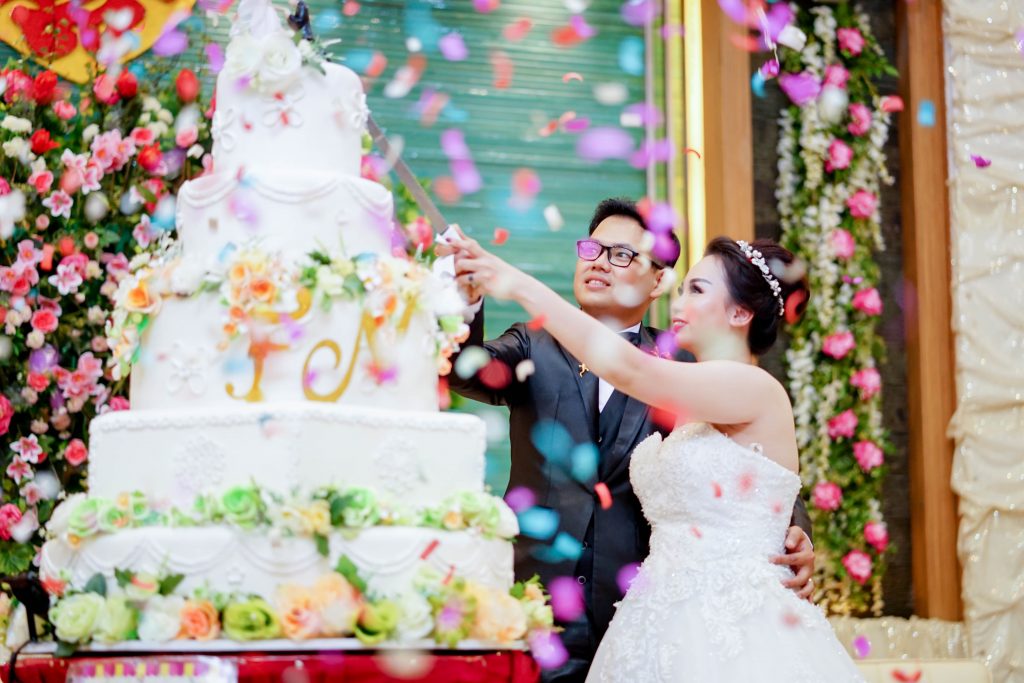The tradition of the wedding cake holds deep historical and cultural significance. Originating from a Roman custom, the breaking of a cake over the bride's head symbolised good fortune and fertility. Over time, the wedding cake has evolved into a representation of prosperity, happiness, and good fortune for the newlyweds. Baking a cake with high-quality ingredients is a way to foreshadow a prosperous and joyful marriage.
Let’s get straight to the point
Wedding cakes have a long history rooted in ancient Roman customs, where breaking a cake over the bride’s head symbolises good fortune and fertility. Today, the wedding cake represents prosperity and happiness for the couple, with key traditions such as cutting the cake together symbolising their shared commitment.
Another tradition linked to good fortune is saving the top tier for a later anniversary or christening. Over time, wedding cakes have evolved, with modern couples choosing alternative desserts or incorporating personal touches into cake designs.
Some charming but lesser-known customs include sleeping with cake under a pillow to dream of a future spouse and pulling wedding cake charms for symbolic fortunes like love or luck. White cakes, once a status symbol in the Victorian era, remain traditional, though couples now personalise cakes to match their wedding theme.
Cutting the cake continues to be a significant moment, representing the couple’s first shared task, their commitment, and the strength of their union. In modern times, wedding cakes have also sparked social debates, particularly regarding same-sex weddings, showing their cultural importance beyond mere dessert.
Ultimately, wedding cakes symbolise love, commitment, and the couple's shared journey.
The Symbolic Act of Cake Cutting

In today's wedding ceremonies, cutting the cake is a highly symbolic moment. Traditionally, the bride would cut the first piece of cake alone, representing her virginity and wishing for a prosperous future. However, modern couples now share this moment, with the bride and groom cutting the cake together. Sharing the cake demonstrates the couple's commitment to sharing everything in their lives, including their fortunes and responsibilities.
The tradition of saving the top tier of the wedding cake is also deeply rooted in history. Couples typically save this portion to enjoy on their first anniversary or at their child's christening, symbolising the continuation of good fortune in their lives.
Wedding Cake Traditions and Their Meanings
Several interesting traditions surround the wedding cake. One custom is for single women at the wedding to take a piece of cake home and sleep with it under their pillow. Legend has it that doing so will bring dreams of their future spouse. Though this tradition may not be as common today, it still holds a charming place in wedding folklore.
Another forgotten but fascinating tradition is the inclusion of charms within the wedding cake. Guests would pull charms, often tied to ribbons, from the cake, each representing a different wish, such as love, luck, or children.
The History and Meaning of Wedding Cakes
Wedding cakes have evolved significantly, with their origins tracing back to ancient Greece and Rome. In those times, wheat cakes symbolised fertility and were broken over the bride’s head to bring good luck. As time went on, wedding cakes became more elaborate, eventually leading to the creation of multi-tiered cakes reflecting a family’s wealth and status.
Modern Wedding Cake Alternatives
While traditional wedding cakes remain popular, many couples now opt for alternative dessert options at their weddings. These alternatives may include mini chocolate apples, caramel tarts, or coconut waffles. Despite the growing variety of dessert options, the wedding cake plays a central role in most celebrations.
Cutting The Cake: A Key Moment In Wedding Photography
Alongside the first dance and bouquet toss, cutting the wedding cake is one of the most frequently photographed moments at a wedding. In modern times, the couple cuts the cake together as a symbolic act of their first shared task as husband and wife. In earlier traditions, the bride would cut the cake alone to symbolise her transition into marriage.
As weddings grew and cakes became more complex, the cake-cutting ceremony became more elaborate. Now, it’s common for a caterer to help with the actual slicing of the cake, particularly for larger gatherings.
The Sharing Of Cake: A Symbol Of Love And Commitment
After cutting the cake, the bride and groom traditionally share a piece. This gesture represents their mutual care and commitment. While some couples may playfully smear cake on each other’s faces, this should be avoided unless the guests are in on the joke, as it can be seen as disrespectful.
Groom's Cake: A Fun and Tasty Tradition
A groom’s cake is a tradition that contrasts with the bride’s cake. It usually features rich chocolate flavors. It’s fun for the groom to have a cake that reflects his tastes and personality.
The Tradition Of Saving The Top Tier
Another long-standing tradition is for newlyweds to save the top tier of their wedding cake to eat on their first anniversary or at their child's christening. Historically, christenings often occurred within a year of the wedding, making this practice more common. Today, many couples still save their top tier to celebrate their first year of marriage, indulging in a slice of cake to relive their wedding day.
Wedding Cake Folklore: Sleeping With Cake Under the Pillow
A charming piece of wedding folklore suggests that single guests should take a slice of the wedding cake and sleep with it under their pillow. According to tradition, this would bring dreams of their future spouse. While modern cakes may not accept such treatment, this tradition adds a whimsy.
Wedding Cake Charms: A Forgotten Tradition
Another tradition that has faded over time is wedding cake charms. In the past, small charms with various symbolic meanings were baked into the cake or attached to ribbons. Guests would pull the ribbons to retrieve their charm, each representing different fortunes. Common charms included:
- Heart: True love
- Ring: An upcoming engagement
- Wishing Well: Wishes coming true
- Highchair: Future children
- Clover or Horseshoe: Good luck
- Rocking Chair: Long life
- Anchor: Adventure
- Flower: New love
- Purse: Wealth and good fortune
- Wedding Bells: Marriage
This playful custom added a layer of fun and excitement to the wedding cake experience.
The Significance of White Wedding Cakes

In the Victorian era, white wedding cakes symbolised wealth and social status. White frosting required expensive ingredients; the lighter the cake, the more it was seen as a sign of affluence. Beyond wealth, white symbolised purity and innocence, hence the term "bride's cake."
Today, white remains a traditional choice for wedding cakes, though couples often personalise their cakes with colours that match their wedding theme or the bride's bouquet.
Conclusion
Wedding cakes have been a part of marriage ceremonies for centuries, evolving in meaning and form but always remaining a symbol of love, prosperity, and commitment. From the Roman tradition of breaking bread to modern customs of saving the top tier, the wedding cake plays a central role in celebrating a couple’s union.
Cutting the cake is a powerful moment, representing the couple’s first joint task and their promise to care for one another. Whether simple or elaborate, white or colorful, wedding cakes are more than just desserts—they reflect the couple’s hopes, dreams, and joy of their shared future.
FAQs About Wedding Cake
Dreams about cakes are a symbol of sweetness and building love. Having an idea like this generates good feelings which then plays a role in the maintenance of relationships. When dreams of cakes are common, that explains to you that you will gain the love, trust and prayers of your friends.
Wedding cakes have their roots in Ancient Rome, when marriage ceremonies ended with a scone-like wheat or barley cake broken over the bride's head for luck and fertility. ... The Brits took the tradition one step further, throwing the bread at the bride to show her fertility, according to The Telegraph.
Yes! Many fake wedding cakes are designed to have a 'slice' removed, so it looks more realistic. Or, we've seen some cakes that are three-tiered, with the top being the only 'real' cake (the bottom two are dummies). So, yes, you can still do a wedding cake cutting.
In modern Western culture, the cake is usually on display and served to guests at the reception. Traditionally, wedding cakes were made to bring good luck to all guests and the couple. Nowadays, however, they are more of a centerpiece to the wedding and are not always even served to the guests.
Cakes are the symbol of sweetness and celebrations. The good times do not need an excuse to knock at your door. This is exactly what a cake denotes in dream.

